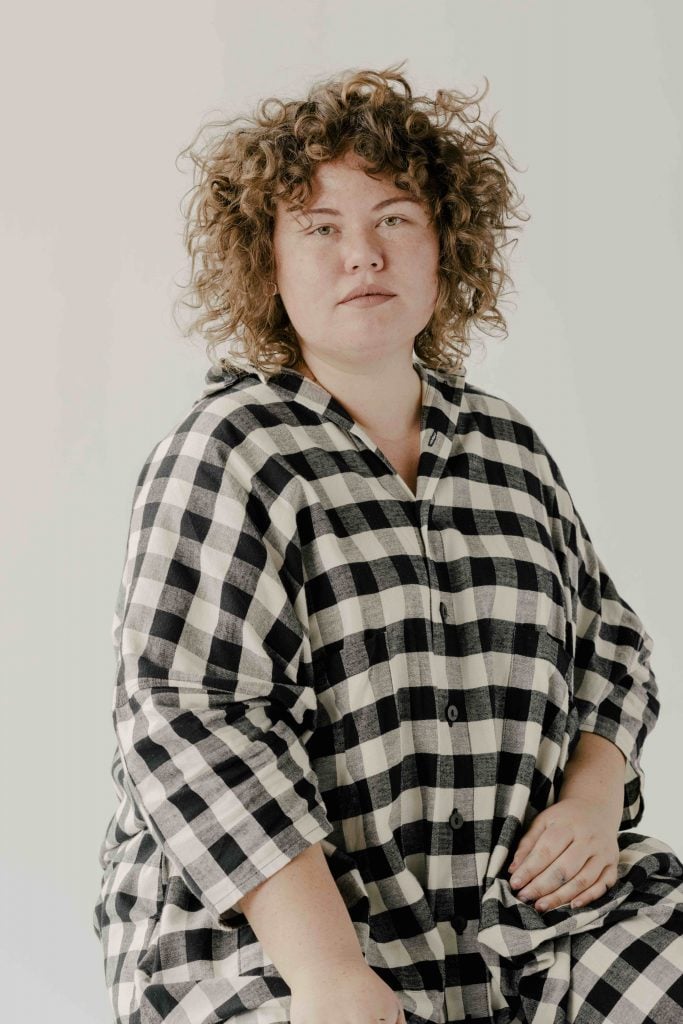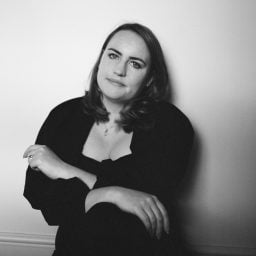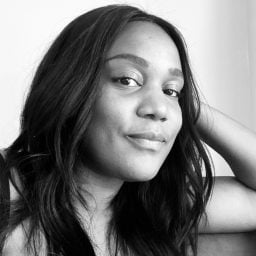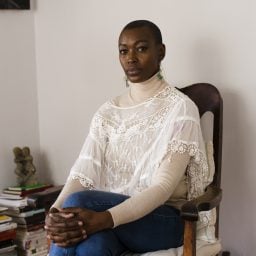Christina Quarles beamed at me from across the Atlantic over Zoom.
The artist was on vacation in Northern California, although in another world she would be in London for Frieze Week, installing her latest solo exhibition at Pilar Corrias. The interruption of travel meant that she had to send the finished works without being there to see them installed.
The 35-year old artist is known for her jumbled-up portraits of intimacy—arms and legs twisted together, raw canvas commanding viewers to fill in blanks between thick impasto brushstrokes. Looking at them is dizzying, like seeing oneself from the inside and outside all at once.
Quarles has spoken in the past about how this disorganized perspective reflects her own way of seeing the world from multiple perspectives, in part due to her own multiracial identity (Quarles has a Black father and white mother) and her identity as a queer woman.
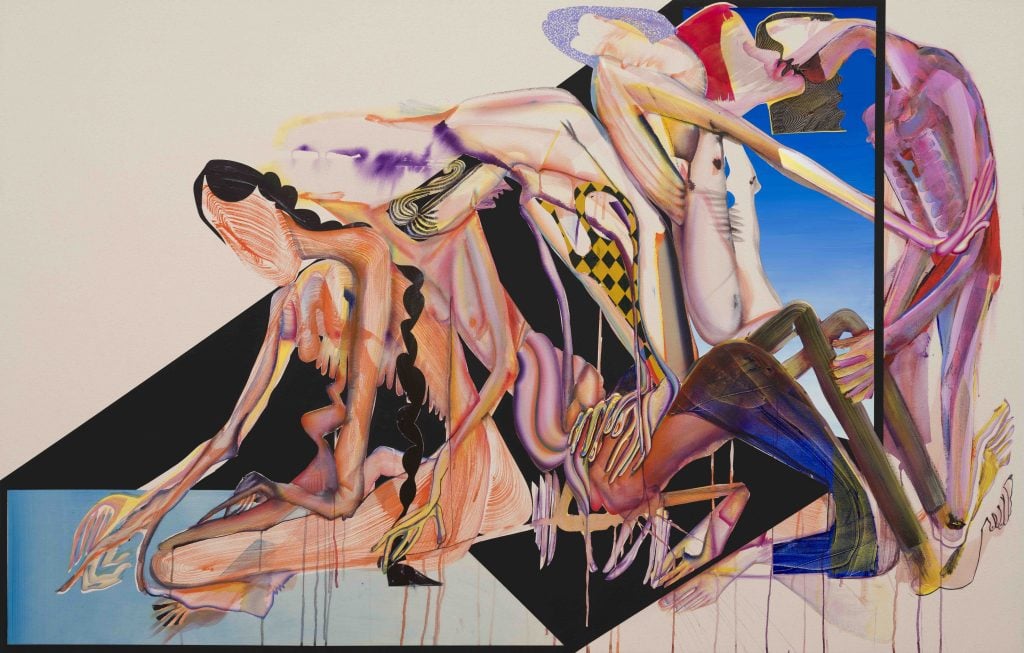
Christina Quarles, Tomorrow Comes Today (Come What May/Cum, Whatever, Maybe) (2020). Courtesy of the artist and Pilar Corrias, London. Photo by Fredrik Nilsen Studio.
Origin Stories
The artist was born in Chicago in 1985 and grew up in a creative family in Los Angeles. As an only child, she often kept herself entertained by drawing and painting, and was encouraged early on to explore her creative side. With her mom raising her alone while working long hours in film and television, Quarles spent a lot of time in after-school programs, including in art classes.
When she was 12 years old, she decided she wanted to be a serious artist. Flipping through a copy of Seventeen magazine at a grocery store, she spotted a story on the Los Angeles County High School for the Arts, and decided it was the one for her. It was there that she met her current studio manager.
When she graduated high school, she ended up choosing a liberal arts school, Hampshire College, rather than another art school.
“I knew how to draw, but I had no good ideas,” she told Artnet News. A double major in philosophy and studio art soon put that right, and after some years working as a graphic designer, she went on to earn an MFA in painting and printmaking from Yale University.
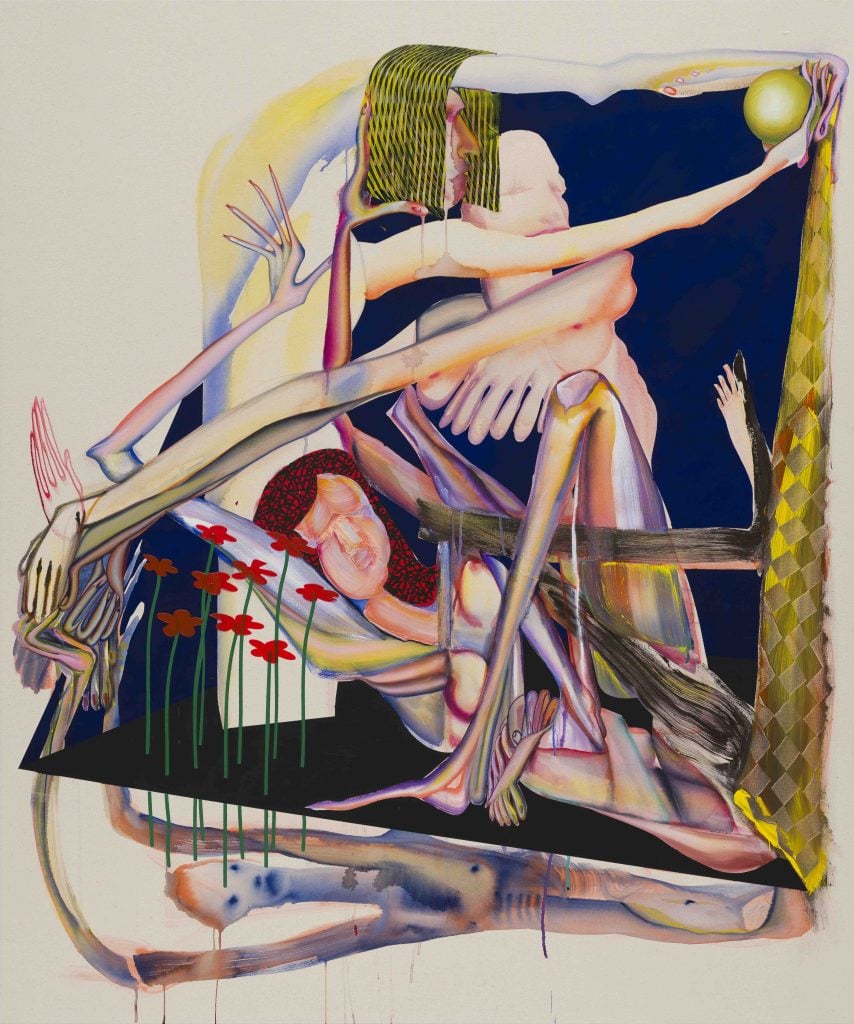
Christina Quarles, I’ll Take Tha Nite Shift (2020). Courtesy of the artist and Pilar Corrias, London. Photo by Fredrik Nilsen Studio.
In her newest body of work, Quarles has been experimenting with qualities of light, and she has altered the tint of the large window in the front of Pilar Corrias’s London gallery so the streaming sunlight takes on an orange glow. The change of light reflects how she felt during quarantine.
“I felt like I was trapped in amber,” she explained—but things got really uncanny when the California wildfires broke out and the sky outside her studio literally turned orange.
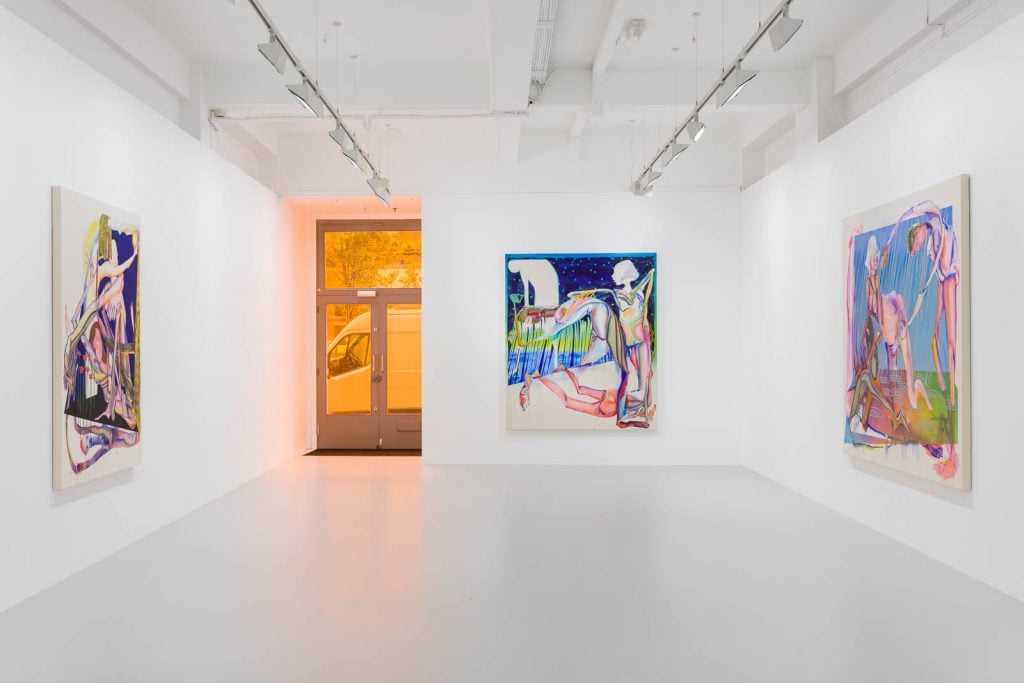
Christina Quarles, installation view “I Won’t Fear Tumbling or Falling/If We’ll be Joined in Another World” at Pilar Corrias, London. Photo by Mark Blower.
All nine paintings in the show were made over the past four months in a small studio at the back of Quarles’s house in Altadena, California, about a 25-minute drive from Los Angeles. The paintings, with slowed-down and detailed moments folding into wild frenzy, mimic how quarantine quietude was often interrupted by the chaos of the internet, with the relentless pace of the news cycle and an endless influx of communication.
“What really surprised me at the beginning was how hard it was to work, considering how I really did have a seamless transition in my work environment,” Quarles said. “But there was still just something about the psychic burden of it all that made it very difficult to concentrate.”
The death of George Floyd was another boiling point.
“I’ve lived with the backdrop of police brutality and violence against Black bodies my entire life, especially growing up in Los Angeles,” she said. (Quarles was seven years old during the 1992 Los Angeles riots.) “Sometimes there are these moments, punctuations of heightened awareness, when something’s just so outrageous you can’t turn away from it.”
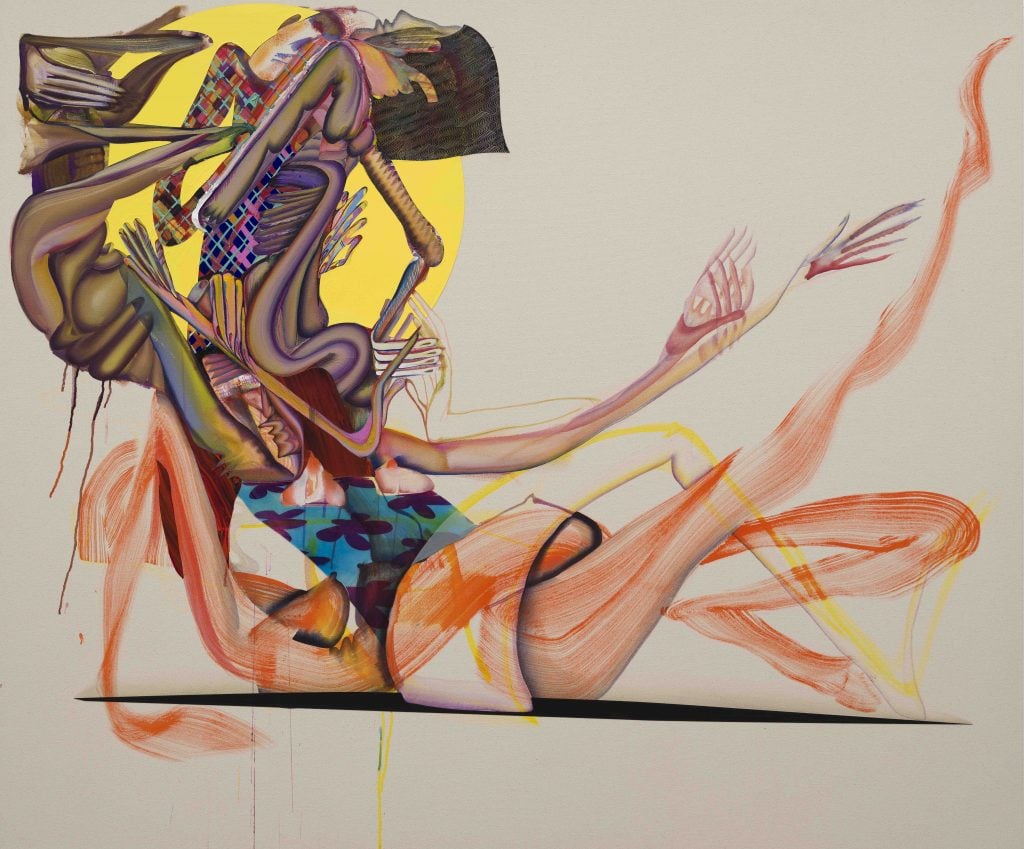
Christina Quarles, They’ll Cut Us Down Again (2020). Courtesy of the artist and Pilar Corrias, London. Photo by Fredrik Nilsen Studio.
Call to Action
The combination of everything thrust Quarles into crisis.
“Every time I think I have a handle on how to deal with the chaos around me, something else comes up,” she said. “There was the pandemic, George Floyd, and then the fires broke out, and suddenly I literally couldn’t breathe the air outside of my house.”
In 2016, after Donald Trump was elected, Quarles still found meaning in making art—but all of a sudden, she said, “it all stopped feeling relevant.” The artist continued to paint but also took the decision to be more explicit with her politics, and to be more varied in her approach to making change. “It’s about making work but it’s also donating to causes with actual money, and speaking out and doing talks.”
Since then, she has raised more than $34,000 for various anti-incarceration organizations, immigration-justice initiatives (including JusticeLA and Black and Pink), and the #MeltICE freedom fund. She has also donated numerous works to charity auctions and exhibitions, including David Zwirner’s fundraiser for Joe Biden’s presidential campaign.
In the next several weeks, as the US gears up for the election, Quarles is focused on encouraging more young people to vote, and has been fundraising for Walk the Walk, a fund for grassroots groups in African American and Latinx communities that aims to fight voter suppression in key swing states. She’s also working with Artists 4 Democracy, a group that engages college-aged voters studying art.
And while she is happy to donate and contribute her time, she has noticed that she is one of a small group of successful artists—many of whom are queer, people of color, and often women—who are being asked to contribute over and over again.
“Why not call in the white artists to donate art? I mean, typically, straight white male artists make more money than people like me in their art anyway,” she said.
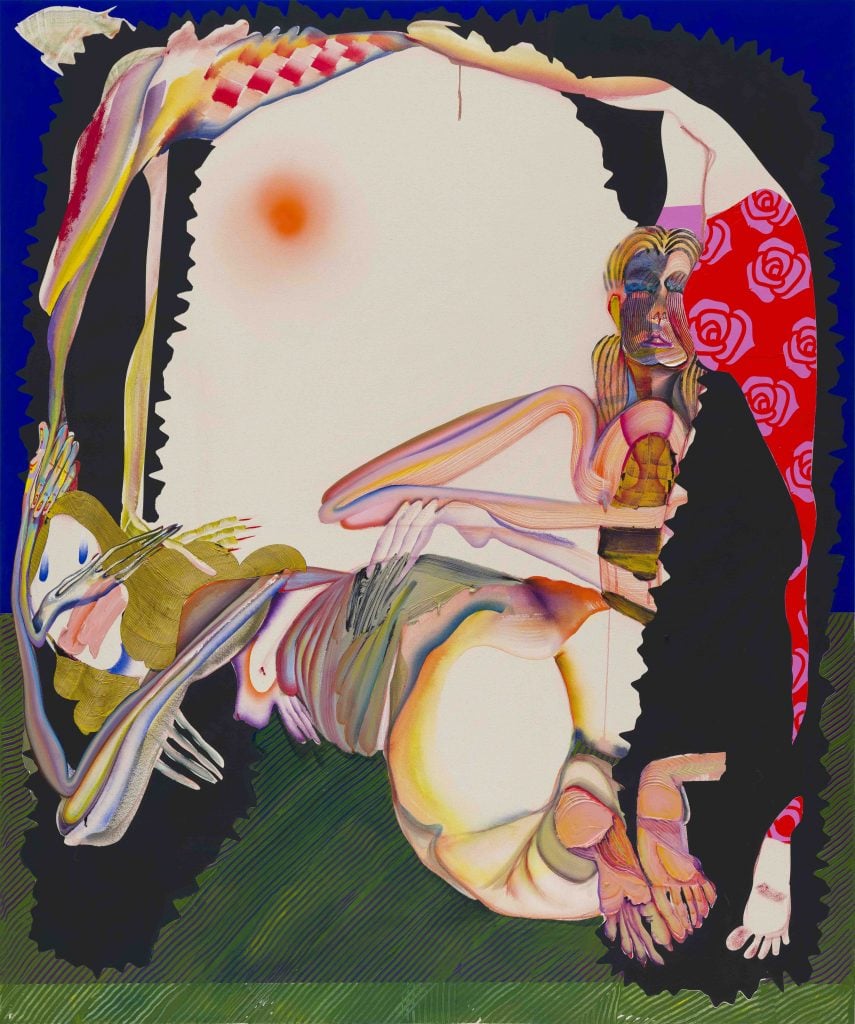
Christina Quarles, Edge of Tomorrow (2020). Courtesy of the artist and Pilar Corrias, London. Photo by Fredrik Nilsen Studio.
After her show in London, Quarles will have two exhibitions in March at the X Museum in Beijing and at the South London Gallery, followed by a solo exhibition at the Museum of Contemporary Art in Chicago in April. She has no idea whether she will be able to travel for any of them.
“In many ways, I think this moment is going to be a really important reset because some things just weren’t sustainable,” Quarles said. More broadly, she feels many systems that were in place were running on fumes even before the pandemic.
“The systems that led to all the inequality in this country—the different levels of access to healthcare and education and technology and housing and safety—were already broken,” she said. “It’s going to be impossible to go back. So, the hope is that all of this sadness and grief will be transformed into a world that is maybe better than the one that we had before.”
In the meantime, Quarles is grateful for her “tight-knit community and support system,” including her wife and her friends.
“I have an incredible support system,” she said. “And so I’ve been trying to think through how to use that for people that don’t have the same support. Because I think a lot of people are really hurting.”
“Christina Quarles: I Won’t Fear Tumbling or Falling/If We’ll be Joined in Another World” is on view at Pilar Corrias in London through November 21.
